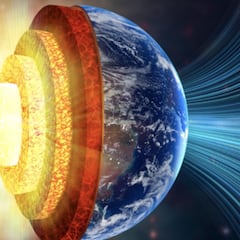What is a geomagnetic storm and how does it affect the Earth?
The first “severe” storm in decades is approaching this weekend with a fantastic light show expected to grace the skies of the US.


A geomagnetic storm is expected to hit Earth this week, potentially causing auroras to be visible as far south as Iowa and Wisconsin.
The storm is being driven by a series of coronal mass ejections (CMEs) from the sun, which have been erupting since Wednesday. These are solar flares emitted by the sun which, once reaching our planet, interact with the atmosphere to create stunning visuals.
The most mesmerising consequence is the creation of auroras. These shimmering light displays, known as the northern lights (aurora borealis) and southern lights (aurora australis), appear when charged particles collide with gases in the atmosphere.
“It’s essentially the Sun shooting a magnet out into space,” Bill Murtagh, program coordinator for the NOAA Space Weather Prediction Center (SWPC), said. “That magnet impacts Earth’s magnetic field and we get this big interaction.”
This is what the Aurora Borealis looks like in real time. Spectacular footage of the Northern Lights captured by photographer Matt Robinson.pic.twitter.com/UF2CLtPWEE
— Wonder of Science (@wonderofscience) March 24, 2024
While the northern lights are usually confined to the Arctic circle, hence the name, the severity of the flares on Monday means the beautiful sight will be seen as far south as Michigan and South Dakota. The best spots to see the aurora will be in Canada and Alaska.
What is a geomagnetic storm?
Our sun is a star filled with constant activity, sending a stream of charged particles called solar wind towards Earth. This wind is usually harmless, deflected by our planet’s magnetosphere - a magnetic shield.
Related stories
However, sometimes the sun throws more forceful punches in the form of these CMEs. These bursts of particles can cause geomagnetic storms, temporary disturbances in the magnetosphere with surprising earthly effects.
While beautiful, geomagnetic storms can also disrupt radio signals used by aircraft, ships, and even GPS. In extreme cases, they can induce currents powerful enough to damage power grids, causing blackouts.

